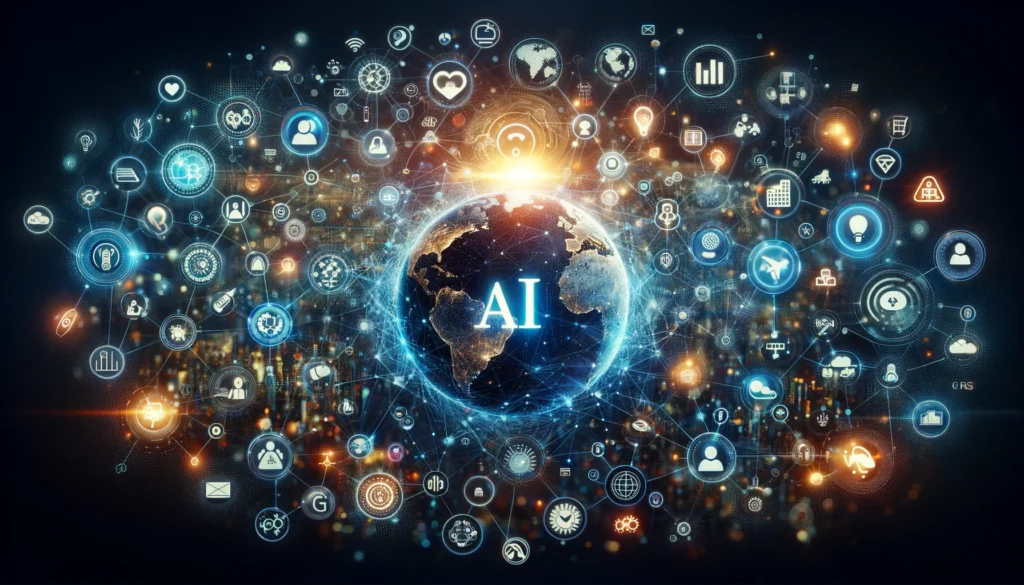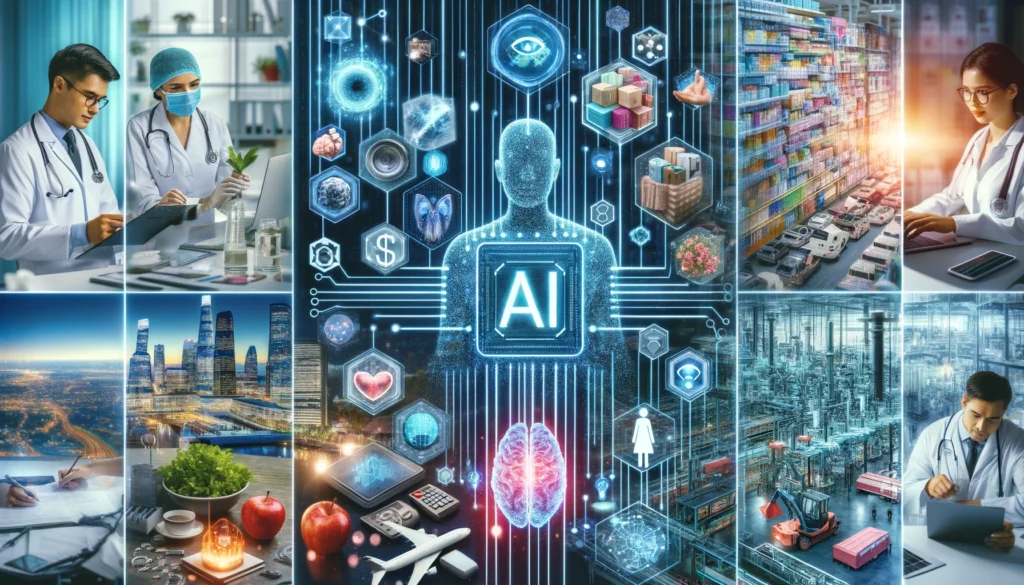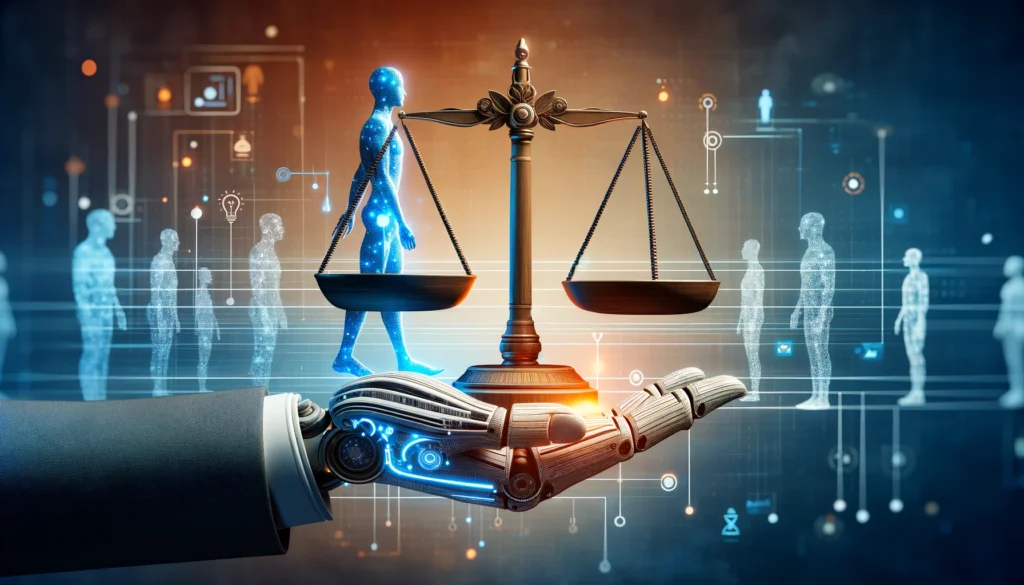In today’s fast-paced and ever-evolving business landscape, From startups to global conglomerates, the integration of Artificial Intelligence in business operations has become not just an option but a necessity.
Artificial Intelligence in Business is not just a buzzword; it’s a transformational force reshaping industries, redefining competition, and driving innovation on a global scale. In this article, we will delve deep into the realm of AI, exploring its significance and the profound impact it has on organizations worldwide.
Table of Contents
Introduction

The possibilities AI unlocks are nothing short of extraordinary, from revolutionizing customer experiences to optimizing supply chains and automating decision-making processes. This article will serve as your comprehensive guide, shedding light on the multifaceted facets of Artificial Intelligence and how businesses across the globe are harnessing its power.
Join us on this journey as we demystify the world of Artificial Intelligence in Business, starting with an understanding of what AI truly entails and then delving into its myriad applications and implications. Whether you’re a seasoned entrepreneur looking to stay ahead of the curve or an aspiring business leader seeking to grasp the AI landscape, this article will equip you with the knowledge you need to navigate this exciting frontier.
In the following sections, we’ll explore the benefits and challenges of implementing AI, examine industry-specific applications, dissect the core technologies and tools, guide successful adoption, peer into the future of AI, and emphasize the importance of ethical and responsible AI practices.
So, fasten your seatbelts, as we embark on a journey into the realm of Artificial Intelligence in Business, where innovation knows no bounds, and the future is limited only by our imagination.
Understanding Artificial Intelligence

Artificial Intelligence, often abbreviated as AI, is a term that has captivated the imaginations of both tech enthusiasts and business leaders alike. To navigate the vast and ever-expanding landscape of AI in business, it’s essential to first grasp the fundamentals.
Definition and Explanation of Artificial Intelligence
At its core, Artificial Intelligence refers to the simulation of human intelligence in machines that are programmed to think and learn like humans. These machines are designed to mimic human cognitive functions such as problem-solving, reasoning, learning, and decision-making. In simpler terms, AI empowers computers to perform tasks that typically require human intelligence, such as recognizing patterns, understanding natural language, and making predictions.
The essence of AI lies in its ability to process vast amounts of data, identify trends, and make informed decisions based on that data. It’s the brain behind virtual assistants like Siri and Alexa, the recommendation algorithms powering your favorite streaming platforms, and the self-driving technology in autonomous vehicles. In business, AI serves as a digital brain that can process and analyze data at speeds and scales beyond human capacity.
Historical Background and Its Evolution in Business
While the concept of AI has been around for decades, its practical applications in business have seen significant advancements in recent years. The roots of AI can be traced back to the mid-20th century when early pioneers like Alan Turing laid the theoretical groundwork. However, it wasn’t until the digital age that AI began to emerge as a powerful tool for businesses.
In the 21st century, businesses started recognizing the potential of AI to streamline operations, enhance customer experiences, and gain a competitive edge. The development of powerful computing hardware, coupled with breakthroughs in machine learning and data analysis, paved the way for AI’s integration into various sectors.
Its Role in Transforming Industries and Markets
The adoption of AI has sparked a revolution across industries, reshaping the way companies operate and compete. From healthcare to finance, retail to manufacturing, AI is a driving force behind unprecedented transformations.
In healthcare, AI algorithms can analyze medical data to diagnose diseases and recommend treatment plans with remarkable accuracy. In finance, AI-powered trading algorithms make split-second decisions to optimize investments. In retail, AI-driven personalization engines tailor shopping experiences to individual preferences. In manufacturing, AI enhances efficiency by predicting equipment maintenance needs.
Furthermore, AI has not only transformed individual businesses but also entire markets. It has redefined customer expectations, opened new revenue streams, and blurred the lines between traditional industries. The companies that embrace AI early gain a significant advantage in terms of efficiency, innovation, and customer satisfaction.
As we continue our exploration of Artificial Intelligence in Business, we will delve deeper into the specific benefits and challenges that come with AI adoption. In the following sections, we will discuss real-world applications, and the technologies behind AI, and provide insights into how businesses can successfully integrate AI into their operations. The journey into the world of AI is just beginning, and the possibilities are boundless.
Benefits of Implementing Artificial Intelligence in Business

Artificial Intelligence isn’t merely a technological trend; it’s a transformative force that promises a multitude of benefits for businesses operating on a global scale. As we dive deeper into our exploration of AI in business, let’s unpack the tangible advantages that organizations can reap from its adoption.
Increased Efficiency and Productivity
One of the primary benefits of integrating Artificial Intelligence into business operations is the significant boost in efficiency and productivity. AI-driven automation can handle repetitive and time-consuming tasks with unmatched speed and precision. This allows employees to focus on more strategic and creative aspects of their work.
For instance, in customer support, chatbots powered by AI can handle routine inquiries, freeing up human agents to deal with complex issues. In manufacturing, AI-driven robots can perform repetitive assembly line tasks without fatigue or errors, leading to higher production rates. These efficiency gains translate into cost savings and a competitive edge.
Cost Reduction and Improved Resource Allocation
AI brings with it the potential to optimize resource allocation and cut unnecessary costs. By analyzing vast datasets, AI systems can identify areas where resources are underutilized or inefficiently allocated. This data-driven approach enables businesses to make informed decisions about resource allocation, reducing waste, and maximizing ROI.
For example, in supply chain management, AI can predict demand fluctuations and help companies adjust their inventory levels accordingly, reducing carrying costs. In energy management, AI can optimize power consumption in buildings, leading to lower utility bills and reduced environmental impact.
Enhanced Decision-Making through Data Analytics
AI’s ability to process and analyze vast amounts of data in real time empowers businesses to make data-driven decisions with a level of precision that was once unimaginable. AI algorithms can identify patterns, trends, and correlations in data that human analysts may overlook, leading to more informed and timely decision-making.
In finance, AI-driven predictive analytics can forecast market trends and investment opportunities. In healthcare, AI can analyze patient data to recommend personalized treatment plans. In marketing, AI can segment audiences and tailor advertising campaigns for maximum impact. These applications not only drive better decision-making but also foster innovation.
Improved Customer Experience and Personalization
One of the standout advantages of AI is its capacity to enhance the customer experience. AI-powered tools and algorithms can analyze customer data to deliver highly personalized experiences and recommendations. This level of personalization not only increases customer satisfaction but also drives revenue growth.
For example, e-commerce platforms use AI to recommend products to customers based on their browsing and purchase history. Streaming services use AI to curate content playlists tailored to individual tastes. AI-driven virtual assistants provide personalized responses and assistance. All of these applications lead to higher customer engagement and loyalty.
Case Studies or Real-world Examples Illustrating These Benefits
To bring these benefits to life, let’s explore a few real-world examples
- Netflix – The streaming giant employs AI to analyze user viewing habits and recommend content. This AI-driven recommendation system is estimated to save Netflix over $1 billion annually by retaining subscribers.
- Amazon – The e-commerce giant uses AI-powered robots in its warehouses to optimize order fulfillment, reducing operating costs and speeding up deliveries.
- Google – Google’s search engine utilizes AI to continuously improve search results, making it more efficient and user-friendly.
These case studies serve as compelling evidence of the tangible benefits that AI can bring to businesses of all sizes and industries. As we progress through this article, we’ll delve deeper into AI’s impact on specific sectors and explore how different industries are harnessing AI to drive innovation and gain a competitive edge.
Challenges and Concerns Artificial Intelligence in Business

While the benefits of integrating Artificial Intelligence into business operations are substantial, it’s crucial to acknowledge the challenges and concerns that come hand-in-hand with this transformative technology. Let’s delve into the multifaceted landscape of AI implementation and explore the hurdles that organizations must navigate.
Common Challenges in Implementing AI
The path to successfully integrating AI into business processes can be riddled with challenges. Some of the common hurdles include
- Data Quality and Availability – AI systems heavily rely on high-quality and relevant data. Organizations often face issues related to data quality, availability, and compatibility across various sources.
- Cost of Implementation – The initial investment required for AI implementation, including hardware, software, and talent acquisition, can be substantial. Smaller businesses may find it challenging to allocate AI resources.
- Lack of AI Expertise – Finding and retaining skilled AI professionals can be challenging. The demand for AI talent far exceeds the current supply, leading to a competitive job market.
- Change Management – Integrating AI often involves significant changes in workflows and processes. Resistance to change from employees and stakeholders can hinder adoption.
Ethical Considerations in AI Adoption
As AI systems become increasingly autonomous and capable of making decisions, ethical considerations come to the forefront. Businesses must grapple with questions related to fairness, transparency, and accountability. Biases present in training data can lead to discriminatory outcomes, and it’s essential to ensure that AI systems make ethical and unbiased decisions.
For instance, AI algorithms used in hiring processes may inadvertently discriminate against certain demographics if historical data contains bias. Ensuring that AI systems adhere to ethical principles is not just a moral obligation but also crucial for maintaining trust with customers and stakeholders.
Security and Privacy Concerns
With AI’s ability to process and analyze vast amounts of data, security and privacy concerns have become paramount. Businesses must safeguard sensitive information and protect it from cyber threats and breaches. AI systems themselves can be vulnerable to attacks if not adequately secured.
Data privacy regulations, such as the General Data Protection Regulation (GDPR), require organizations to be transparent about how they collect and use data. Ensuring compliance with such regulations while harnessing the power of AI presents a complex challenge.
Addressing Potential Job Displacement Fears
The automation capabilities of Artificial Intelligence have sparked concerns about job displacement. While AI can take over repetitive and mundane tasks, there are valid worries about the impact on the workforce. Addressing these concerns requires proactive efforts to reskill and upskill employees.
Businesses need to invest in workforce development programs to equip employees with the skills needed to work alongside AI systems. It’s essential to communicate that AI is a tool to augment human capabilities rather than replace them.
Navigating these challenges and concerns is an integral part of the journey toward successful AI adoption in business. Organizations that are proactive in addressing these issues are better positioned to harness the full potential of AI while mitigating risks and ensuring ethical and responsible use.
As we progress through this article, we’ll explore industry-specific applications of AI and delve into the technologies and tools that underpin its implementation. By understanding the challenges and opportunities, businesses can make informed decisions about how to leverage AI for sustainable growth and innovation.
Industry-Specific Applications

Artificial Intelligence is a versatile and transformative force that transcends industry boundaries. In this section, we’ll delve into how AI is revolutionizing various sectors, from healthcare to customer service, and provide real-world examples that illustrate its remarkable impact.
1. Healthcare
AI’s Healing Touch: In the realm of healthcare, Artificial Intelligence has emerged as a lifeline, driving innovations that enhance patient care, diagnosis, and treatment.
- Medical Imaging – AI-powered algorithms can analyze medical images such as X-rays, MRIs, and CT scans with remarkable precision, aiding radiologists in detecting diseases and anomalies at an early stage.
- Drug Discovery – AI accelerates drug discovery processes by predicting potential drug candidates, optimizing molecular structures, and reducing the time and cost associated with bringing new medicines to market.
- Personalized Medicine – AI analyzes patient data to tailor treatment plans based on an individual’s genetic makeup, improving the effectiveness of therapies while minimizing side effects.
- Healthcare Chatbots – Virtual health assistants powered by AI provide immediate responses to patient queries, offer medical advice, and even assist in medication management.
- Real-World Example – IBM’s Watson for Oncology analyzes vast volumes of medical literature and patient data to provide oncologists with treatment recommendations, significantly improving the accuracy of cancer care.
2. Finance
- AI in the Financial World – The financial industry relies heavily on data-driven decision-making, making it a prime candidate for AI-driven advancements.
- Algorithmic Trading – AI algorithms execute high-frequency trading with speed and precision, optimizing investment portfolios and reducing risk.
- Fraud Detection – AI can analyze transaction data in real-time to identify fraudulent activities, protecting both financial institutions and their customers.
- Credit Scoring – AI assesses creditworthiness by considering a wider range of data, improving accuracy in lending decisions.
- Customer Service – Chatbots and virtual assistants enhance customer interactions by providing 24/7 support, answering queries, and assisting with account-related tasks.
- Real-World Example – Goldman Sachs uses AI algorithms to analyze market conditions and execute complex trades, achieving better results and outperforming traditional trading strategies.
3. Retail
- AI in the Shopping Cart – Retailers leverage AI to enhance customer experiences and optimize supply chains.
- Recommendation Engines – AI-driven recommendation systems personalize product suggestions based on customer preferences and browsing history.
- Inventory Management – AI predicts demand, minimizes overstocking and understocking issues, and streamlines inventory management.
- Visual Search – AI-powered visual search allows customers to find products by uploading images, simplifying the shopping process.
- Virtual Try-On – Augmented reality and AI enable virtual try-on experiences, helping customers visualize products like clothing and cosmetics.
- Real-World Example – Amazon’s recommendation system suggests products based on customer behavior, contributing to a significant increase in sales and customer retention.
4. Manufacturing
- AI on the Factory Floor – AI enhances manufacturing efficiency, quality control, and maintenance processes.
- Predictive Maintenance – AI analyzes equipment data to predict maintenance needs, reducing downtime and extending the lifespan of machinery.
- Quality Control – Computer vision powered by AI can identify defects in real-time, improving product quality.
- Supply Chain Optimization – AI optimizes the supply chain by predicting demand, optimizing routes, and managing inventory.
- Robotic Automation – AI-driven robots perform intricate tasks with precision, reducing human error and labor costs.
- Real-World Example – Siemens uses AI-powered algorithms to optimize manufacturing processes, resulting in a 30% reduction in production costs.
5. Marketing
- AI-Powered Marketing – AI revolutionizes marketing strategies by providing insights, automating campaigns, and enhancing targeting.
- Predictive Analytics – AI analyzes customer data to predict future behavior, enabling marketers to create more effective campaigns.
- Content Personalization – AI tailors content to individual preferences, increasing engagement and conversion rates.
- Chatbots and Conversational Marketing – AI-driven chatbots provide immediate responses and assistance, improving customer engagement.
- Ad Campaign Optimization – AI automates ad campaign management by optimizing ad spend and targeting, ensuring the best ROI.
- Real-World Example – Spotify uses AI to curate personalized playlists for users, leading to increased user satisfaction and longer engagement.
6. Customer Service
- AI-Powered Customer Support – AI-driven customer service solutions enhance responsiveness and efficiency.
- Chatbots and Virtual Assistants – AI chatbots provide instant responses to customer inquiries, reducing response times and improving satisfaction.
- Language Processing – AI-powered language processing tools enable companies to understand customer sentiment and feedback at scale.
- Voice Assistants – Voice-activated AI assistants offer hands-free customer service, enhancing accessibility and convenience.
- Customer Feedback Analysis – AI algorithms analyze customer feedback to identify trends and areas for improvement.
- Real-World Example – Airbnb uses AI-powered chatbots to handle routine inquiries and streamline the booking process, improving the user experience.
These real-world examples underscore the transformative potential of Artificial Intelligence in Business Or across various industries. As we move forward in our exploration of AI in business, we’ll dive deeper into the core technologies that drive AI applications and provide guidance on successful AI adoption strategies. The possibilities are vast, and the business world is just scratching the surface of AI’s potential.
Artificial Intelligence in Business – Technologies and Tools

In our journey to unravel the world of Artificial Intelligence in Business, it’s essential to understand the core technologies and tools that power this transformative force. In this section, we’ll explore the diverse array of AI technologies and provide insights into the building blocks of AI applications.
Overview of the Various AI Technologies and Tools Available
Artificial Intelligence encompasses a broad spectrum of technologies and tools, each serving a unique purpose in solving complex problems. Some of the key AI technologies and tools include:
- Machine Learning (ML) – ML is the foundation of AI. It involves the development of algorithms and models that enable computers to learn from data and make predictions or decisions. Supervised learning, unsupervised learning, and reinforcement learning are common ML approaches.
- Natural Language Processing (NLP) – NLP focuses on enabling computers to understand, interpret, and generate human language. It plays a vital role in chatbots, language translation, sentiment analysis, and speech recognition.
- Computer Vision – Computer vision allows machines to interpret and make sense of visual information from the world, such as images and videos. This technology is behind facial recognition, object detection, and autonomous vehicles.
- Deep Learning – Deep learning is a subset of ML that involves neural networks with multiple layers (deep neural networks). It excels in tasks requiring complex pattern recognition, such as image and speech recognition.
- Reinforcement Learning – This ML approach involves agents learning to make sequences of decisions in an environment to maximize a reward signal. It’s commonly used in robotics and game-playing AI.
- Natural Language Generation (NLG) – NLG technology generates human-like text based on structured data. It’s used in automated content generation, report writing, and storytelling.
Explanation of Machine Learning, Natural Language Processing, and Computer Vision
- Machine Learning (ML) – At its core, ML is about training algorithms to recognize patterns in data and make predictions or decisions based on those patterns. For example, it can be used to predict customer behavior, classify images, or recommend products.
- Natural Language Processing (NLP) – NLP focuses on enabling computers to understand and process human language. This includes tasks like sentiment analysis, language translation, and chatbot interactions. NLP algorithms can extract meaning from text, allowing machines to communicate effectively with humans.
- Computer Vision – Computer vision allows machines to analyze and interpret visual information. It enables AI systems to recognize objects, people, and scenes in images and videos. Computer vision has applications in security, autonomous vehicles, and healthcare, among others.
Mention of Popular AI Frameworks and Platforms
To harness the power of AI, businesses often turn to established AI frameworks and platforms that provide tools and libraries for developing AI applications. Some of the popular AI frameworks and platforms include:
- TensorFlow – Developed by Google, TensorFlow is an open-source machine learning framework widely used for deep learning tasks. It offers a flexible ecosystem for building and deploying AI models.
- PyTorch – Developed by Facebook’s AI Research lab, PyTorch is another open-source machine learning framework known for its dynamic computation graph and ease of use. It’s favored by researchers and developers for its flexibility.
- Microsoft Azure – Microsoft’s cloud computing platform, Azure, offers a range of AI tools and services, including Azure Machine Learning and Azure Cognitive Services, making it easier for businesses to integrate AI into their workflows.
- Amazon Web Services (AWS) – AWS provides a comprehensive suite of AI services, including SageMaker for machine learning and Rekognition for computer vision. It offers scalable solutions for AI development and deployment.
- IBM Watson – IBM’s Watson platform offers a suite of AI tools and services, enabling businesses to build and deploy AI applications, conduct data analysis, and implement natural language processing.
As we progress through this article, we’ll explore how businesses can leverage these AI technologies and tools to address specific challenges, optimize processes, and unlock new opportunities. Understanding the AI landscape is essential for organizations looking to harness the full potential of this transformative technology.
Implementing Artificial Intelligence in Your Business

Now that we’ve explored the vast landscape of Artificial Intelligence technologies and tools, it’s time to roll up our sleeves and dive into the practical aspects of integrating AI into your business. In this section, we’ll outline the steps and considerations that will guide you on your journey to successful AI adoption.
1. Assessing Readiness
Before diving headfirst into AI implementation, it’s essential to assess your organization’s readiness for this transformative technology. Consider the following factors:
- Data Availability – Do you have access to relevant and high-quality data that can fuel AI algorithms? Data is the lifeblood of AI, so having a robust data strategy is crucial.
- Technical Infrastructure – Evaluate your current technical infrastructure. Does it support AI deployment, or do you need to invest in hardware and software upgrades?
- Skill Sets – Assess the skill sets within your organization. Do you have team members with the necessary expertise in AI and data science, or do you need to hire or upskill existing employees?
Business Strategy Alignment: Ensure that your AI initiatives align with your broader business strategy and goals. Identify areas where AI can create value and drive outcomes.
2. Setting Clear Objectives
Clear and well-defined objectives are essential for any AI implementation. What specific goals do you want to achieve with AI? Whether it’s improving customer service, optimizing supply chains, or enhancing decision-making, setting clear objectives will guide your AI strategy.
- SMART Objectives – Ensure that your objectives are Specific, Measurable, Achievable, Relevant, and Time-bound (SMART). This makes it easier to track progress and measure the success of your AI initiatives.
3. Data Collection and Preparation
As mentioned earlier, data is the lifeblood of AI. It’s crucial to establish robust data collection and preparation processes. This includes:
- Data Collection – Gather relevant data from various sources, ensuring it’s clean, complete, and up-to-date.
- Data Storage – Implement a secure and scalable data storage solution that can handle the volume of data required for AI.
Data Cleaning and Preprocessing: Prepare data by cleaning, transforming, and normalizing it for use in AI models.
4. Choosing the Right AI Solution
Selecting the appropriate AI solution for your business needs is a critical step. Consider the following factors:
- Off-the-Shelf vs. Custom Solutions – Decide whether to opt for pre-built AI solutions or develop custom solutions tailored to your specific requirements.
- Scalability – Ensure that the chosen AI solution can scale with your business as it grows.
- Cost Considerations – Evaluate the total cost of ownership, including development, deployment, and ongoing maintenance.
- Security and Compliance – Assess the security and compliance aspects of your chosen AI solution, especially if handling sensitive data.
5. Training and Upskilling Employees
To make the most of AI, your employees need to understand how it works and how to use it effectively. Consider these steps:
- Training Programs – Invest in AI training programs for employees to build their AI literacy and proficiency.
- Change Management – Implement change management strategies to ensure a smooth transition to AI-powered processes and workflows.
- Encourage Innovation – Foster a culture of innovation where employees feel encouraged to explore AI-driven solutions and contribute their ideas.
6. Best Practices and Tips for a Successful Implementation
Implementing AI successfully requires careful planning and execution. Here are some best practices and tips to guide you:
- Start Small – Begin with pilot projects or smaller AI implementations to gain experience and build confidence.
- Data Governance – Establish strong data governance practices to ensure data quality, privacy, and compliance.
- Monitor and Iterate – Continuously monitor the performance of your AI systems and be prepared to iterate and improve them over time.
- Collaboration – Encourage cross-functional collaboration between data scientists, IT, and business units to ensure AI projects align with business goals.
- Measure ROI – Regularly measure the return on investment (ROI) of your AI initiatives to assess their impact on the organization.
As you embark on your journey to implement AI in your business, keep in mind that AI is not a one-size-fits-all solution. Tailor your approach to your specific needs, and don’t hesitate to seek guidance from experts in the field. With careful planning and strategic execution, AI can become a powerful driver of innovation, efficiency, and growth for your organization.
AI Trends and Future Outlook

Artificial Intelligence is a dynamic field that constantly evolves with new developments and innovations. In this section, we’ll explore the current trends in AI for businesses and offer insights into the potential future impact of AI on the global business landscape.
Current Trends in AI for Businesses
AI is in a state of constant evolution, and staying up-to-date with the latest trends is crucial for businesses aiming to harness its full potential. Here are some of the current trends in AI:
- AI-Powered Automation – Businesses are increasingly using AI to automate repetitive tasks across various departments, including customer service, finance, and manufacturing. This not only improves efficiency but also allows employees to focus on more strategic and creative tasks.
- Conversational AI – Chatbots and virtual assistants have become essential tools for businesses. They provide immediate customer support, answer queries, and enhance the overall customer experience.
- AI in Healthcare – AI applications in healthcare continue to grow, with advancements in medical imaging, drug discovery, and patient care. AI-powered diagnostics and personalized treatment plans are becoming more common.
- AI in Finance – In the financial sector, AI is used for algorithmic trading, fraud detection, and credit scoring. The ability to process vast amounts of financial data in real-time is transforming the industry.
- AI in Marketing – AI-driven marketing automation tools are being used to personalize customer experiences, optimize ad campaigns, and analyze consumer behavior. Predictive analytics and recommendation engines are enhancing marketing strategies.
Exploration of AI’s Potential Future Impact on the Global Business Landscape
The future of AI holds immense promise for the global business landscape. Here are some key areas where AI is poised to make a significant impact:
- AI-Enhanced Decision-Making – AI will continue to play a pivotal role in decision-making processes, offering data-driven insights that lead to more informed and strategic choices. Businesses will rely on AI to gain a competitive edge.
- Hyper-Personalization – AI’s ability to analyze large datasets will lead to hyper-personalized customer experiences. Products, services, and marketing messages will be tailored to individual preferences with incredible precision.
- Supply Chain Optimization – AI will revolutionize supply chain management by predicting demand, optimizing logistics, and minimizing waste. Real-time data analysis will enhance agility and resilience in supply chains.
- AI-Driven Innovation – AI will drive innovation by accelerating research and development processes. Businesses will use AI to discover new materials, optimize product design, and identify market opportunities.
- AI in Sustainability – AI will play a crucial role in sustainability efforts. It will be used to optimize energy consumption, reduce emissions, and develop eco-friendly products and processes.
Predictions and Insights from Experts in the Field
Leading experts in the field of AI offer valuable insights and predictions:
- Gartner’s Hype Cycle – Gartner predicts that AI will continue to advance rapidly, with AI-augmented architecture and responsible AI among the emerging trends. They emphasize the importance of ethical AI practices.
- McKinsey & Company – McKinsey forecasts that AI’s economic impact could reach $13 trillion by 2030. They highlight AI’s potential to reshape industries and improve productivity.
- AI Thought Leaders – Experts like Andrew Ng and Fei-Fei Li emphasize the need for AI to be accessible and understandable by non-experts. They envision AI as a tool for democratizing knowledge and decision-making.
In conclusion, Artificial Intelligence is poised to be a transformative force in the global business landscape. Current trends show its increasing adoption across various sectors, while the future promises even greater impact. Businesses that embrace AI strategically and ethically are likely to thrive in this era of technological innovation. As AI continues to evolve, staying informed and adaptable will be key to harnessing its full potential.
Ethical and Responsible Artificial Intelligence in Business

As businesses embrace the transformative power of Artificial Intelligence, it is imperative to ensure that AI is deployed responsibly and ethically. In this section, we’ll delve into the importance of ethical AI practices in business and explore key considerations related to fairness, transparency, and bias in AI algorithms, as well as compliance with AI regulations and guidelines.
The Importance of Ethical Artificial Intelligence in Business
Ethical AI practices are essential in business for several compelling reasons
- Trust and Reputation – Businesses that prioritize ethical AI gain the trust of their customers, partners, and stakeholders. Ethical behavior fosters a positive reputation and strengthens brand loyalty.
- Legal and Regulatory Compliance – Violations of ethical AI principles can lead to legal and regulatory consequences. Compliance with AI regulations and guidelines is not just a moral imperative but also a legal requirement in many jurisdictions.
- Customer Satisfaction – Ethical AI practices, such as fair and transparent algorithms, lead to improved customer satisfaction. When customers feel that their data is handled responsibly, they are more likely to engage with AI-driven services and products.
- Mitigating Bias – Ethical AI practices aim to minimize bias in algorithms, ensuring that AI systems do not discriminate against specific groups or individuals. Bias can have detrimental effects on fairness and equality.
Fairness, Transparency, and Bias in AI Algorithms
Fairness, transparency, and bias are critical aspects of ethical AI:
- Fairness – AI algorithms should be designed to treat all individuals and groups fairly, without favoring or discriminating against any particular demographic. It involves assessing and mitigating bias in AI models to prevent discriminatory outcomes.
- Transparency – Transparency in AI refers to making the inner workings of AI systems understandable and interpretable. Transparent AI systems are accountable, and their decision-making processes can be examined and explained.
- Bias – Bias in AI algorithms can stem from biased training data or flawed algorithms. It can result in discriminatory decisions, reinforcing existing inequalities. Businesses must actively address and rectify bias to ensure fairness.
Compliance with AI Regulations and Guidelines
Governments and regulatory bodies are increasingly recognizing the need to regulate AI to ensure ethical and responsible use. Businesses must be aware of and compliant with relevant AI regulations and guidelines. Key considerations include –
- General Data Protection Regulation (GDPR) – GDPR sets stringent requirements for the processing of personal data, including AI applications. Organizations must obtain consent, provide transparency, and ensure data privacy.
- Algorithmic Accountability Act – In the United States, this act proposes transparency and accountability for automated decision-making systems. It aims to mitigate bias and discrimination in AI algorithms.
- AI Ethics Guidelines – Various organizations, including the IEEE and the European Commission, have established ethical guidelines for AI development and deployment. Adhering to these guidelines promotes responsible AI practices.
- Fair Lending Laws – In the financial sector, fair lending laws prohibit discriminatory practices in credit scoring and lending decisions. AI systems used in finance must comply with these regulations.
Best Practices for Ethical and Responsible AI in Business
To ensure ethical and responsible AI in your business, consider these best practices –
- Diverse and Inclusive Data – Use diverse and representative datasets when training AI models to minimize bias. Ensure that the data used reflects the diversity of your user base.
- Algorithmic Fairness Testing – Regularly test AI algorithms for fairness and bias using appropriate metrics and techniques. Implement bias mitigation strategies when necessary.
- Explainable AI – Invest in AI technologies that offer interpretability and transparency. Explainable AI allows you to understand and communicate how AI decisions are made.
- Ethics Training – Provide ethics training to your AI development and deployment teams. Ensure that employees understand the ethical implications of their work.
- Continuous Monitoring – Continuously monitor AI systems in production to detect and rectify any biases or ethical issues that may arise over time.
- User Consent and Transparency – Communicate to users how their data will be used and seek their informed consent. Provide transparency regarding AI-driven processes.
- Independent Audits – Consider third-party audits of your AI systems to ensure compliance with ethical guidelines and regulations.
By prioritizing ethical and responsible AI practices, businesses can not only mitigate risks but also build a foundation of trust with customers and stakeholders. Ethical AI aligns with long-term sustainability and ensures that AI technology benefits society as a whole, fostering a more equitable and just future.
X. Conclusion

In the ever-evolving landscape of modern business, the role of Artificial Intelligence (AI) has grown from a technological trend to a transformative force that is reshaping industries and markets worldwide. As we conclude our exploration of “Artificial Intelligence in Business,” let’s recap the key takeaways and emphasize the significance of AI in the corporate world.
The Significance of AI in Business
Artificial Intelligence in business is not just a buzzword; it’s a catalyst for innovation, efficiency, and growth. Businesses that harness the power of AI gain a competitive edge by:
- Enhancing Efficiency – AI automates mundane tasks, freeing up employees to focus on strategic and creative aspects of their work. This leads to increased efficiency and productivity.
- Optimizing Resource Allocation – AI optimizes resource allocation, reducing costs and minimizing waste. It enables organizations to make data-driven decisions for better resource management.
- Improving Decision-Making – AI analyzes vast datasets to provide insights that lead to informed and timely decision-making. It identifies patterns, trends, and correlations that human analysts might overlook.
- Enhancing Customer Experience – AI personalizes customer experiences, making them more engaging and satisfying. Businesses can provide tailored recommendations, responses, and support.
- Fostering Innovation – AI accelerates innovation by streamlining research and development processes. It identifies new opportunities and helps organizations stay at the forefront of their industries.
Embracing AI Responsibly
As we conclude, it’s crucial to reiterate the importance of embracing AI responsibly. Responsible AI practices encompass ethical considerations, fairness, transparency, and compliance with regulations. Businesses that prioritize ethics and responsible AI not only mitigate risks but also build trust with customers, partners, and stakeholders.
In closing, the era of Artificial Intelligence in business is here to stay, and its impact will only continue to grow. Whether you’re in healthcare, finance, retail, manufacturing, marketing, or any other sector, AI offers opportunities for innovation and transformation. By understanding the potential of AI, adopting it strategically, and adhering to ethical principles, businesses can navigate this exciting landscape and pave the way for a brighter and more prosperous future. Embrace AI, and let it be your partner in achieving new heights of success.
FAQ’s
What is the significance of Artificial Intelligence in the business world?
Artificial Intelligence plays a crucial role in enhancing efficiency, optimizing resource allocation, improving decision-making, enhancing customer experiences, and fostering innovation within businesses. It’s a transformative force that offers a competitive edge and drives growth.
How can businesses ensure ethical AI practices in their operations?
Businesses can ensure ethical AI practices by using diverse and inclusive data, implementing algorithmic fairness testing, investing in explainable AI, providing ethics training to employees, and continuously monitoring AI systems. Compliance with AI regulations and guidelines is also crucial.
What are some current trends in AI for businesses?
Current trends in AI for businesses include AI-powered automation, conversational AI (chatbots and virtual assistants), AI in healthcare, AI in finance, and AI-driven marketing. These trends are reshaping industries and enhancing customer experiences.
How can businesses assess their readiness for AI adoption?
Assessing readiness for AI adoption involves evaluating data availability, technical infrastructure, skill sets within the organization, and alignment with business strategy. It’s essential to ensure that your organization has the necessary resources and data to embark on an AI journey.

